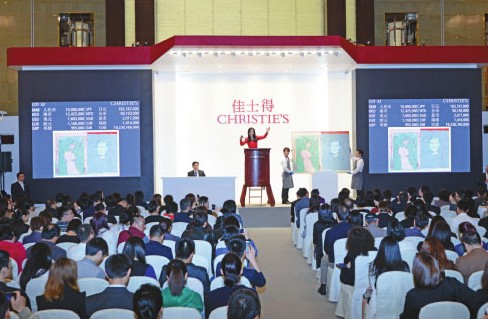

The auction scene in Christie's 2014 Spring Auction in Shanghai in April. Christie's' global sales reached $7.13 billion in 2013, up 14 percent from a year earlier. Provided to China Daily
Auctioneer looks to China to build on record industry sales for last year
Six months ago Christie's debuted on China's mainland as a sole-funded international auction house. Cai Jinqing remembers the live auction well and talks animatedly about its unexpectedly warm response.
Cai became Christie's China president in February, promoted from managing director in the firm she joined in 2012.
Christie's is the world's leading auction house by sales and the first international fine art auctioneer licensed to operate on China's mainland independently.
That first auction, in Shanghai last September, drew attention across the industry, from art collectors, buyers, artists and investors. It grossed 154 million yuan ($24.98 million).
Pablo Picasso's Seated Man, sold for 9.6 million yuan. It was the first work to sell on the Chinese mainland by arguably the most important artist of the last century.
"We were really thrilled at the warm responses from all kinds of participants in the circle, from buyers to media reporters," Cai said. It "was far beyond our expectation."
About two-thirds of buyers came from the mainland, the rest from over the globe.
The sale showcased China's potential and fueled Christie's confidence to develop in the world's fastest-growing art market.
Christie's has embarked on building closer connections with local clients and improving services throughout the process; from storage to post-sale client services.
"We offer the global service experience to our local clients with our global team of employees, from experts in different art categories to the operational staff," Cai said.
Although Shanghai-based, behind every expert or staff member here there is a global team guaranteeing local clients get the same service as in New York, Paris or London, she said.
The London-based firm was established in 1766. Its experience, talent pool and reputation is global. Still, it's restricted from selling Chinese cultural relics such as porcelains, ancient paintings and some antiques. That makes it tough to predict Christie's prospects in China.
It needs to work out how to adapt to government restrictions and differences in domestic tastes compared with those overseas, according to observers.
The Shanghai Pilot Free Trade Zone was officially launched in 2013. It sparked talk that curbs may be lifted on the sale of cultural relics by foreign-funded auction houses in the zone. If they were, it would be an opportunity for Christie's.
"Cultural relics' sale has been a significant part of Christie's total business ever since it was founded, and we have been working on developing this business all the time," Cai said. "However, all of our strategies and efforts are long-term ones, not just targeting the immediate benefits, which enables us to react in a better way to all the possible opportunities."
As of 2012, there were about 400 auction houses in China, 309 of which were licensed by the State Administration of Cultural Heritage to sell cultural artifacts. The number of houses in China is growing. TEFAF Maastricht, an internationally recognized body in the art market, counted 108 in 2005. That's about 70 percent fewer than now.
Before Christie's, Cai worked in public relations, joining global financial PR firm Brunswick Group LLP in 2005. There she took part in projects involving Chinese enterprises' overseas investment.
Those experiences offered the Princeton graduate the experience to promote an exchange between Chinese companies and the global market as well as overseas corporations looking to do business in China, with the world's second-biggest economy.
Cai said her work reflects that experience as Christie's seeks to facilitate a two-way relationship between Chinese collectors and artists with their counterparts abroad.
"Promoting the integration of Chinese and Western art is one of our top priorities in the long term," Cai said.
Chinese collectors prefer impressionist art, she said.
"Impressionist paintings share something in common with traditional Chinese ink and wash paintings, making Chinese collectors" inclined to appreciate it, she said.
Christie's in 2013 had record sales for any auction house; $7.13 billion, up 14 percent from a year earlier. Business was driven by new buyers in emerging markets-including China and India-and Internet sales.
According to the company's financial report for the year, 30 percent of buyers were new and generated 22 percent of total sales.
Chinese buyers, new and old, accounted for 22 percent of global sales, up 63 percent year-on-year.
Beijing has overtaken Hong Kong as the center of China's art trade. The mainland has generated more than 80 percent of market share by sales in art since 2009. That's even as Hong Kong clawed back some in 2012, expanding to 17 percent from 5 percent, according to a report by TEFAF Maastricht.
The art market, supported by China's economic growth of recent years, is being driven by unprecedented opportunities brought from technological improvement and the Chinese people's growing spiritual demand, Cai said.
"Technology removed the barriers in space and time for fine art auctions and private sales and gives a big boost to our online-only sales," Cai said.
Copyright ©1999-2018
Chinanews.com. All rights reserved.
Reproduction in whole or in part without permission is prohibited.